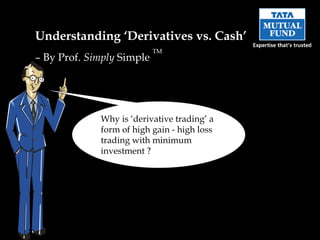
Prof. simply simple derivatives vs cash
- 1. Understanding ‘Derivatives vs. Cash’ TM – By Prof. Simply Simple Why is ‘derivative trading’ a form of high gain - high loss trading with minimum investment ?
- 2. We have seen in our earlier lessons that dividend trading is about a bet on movements of “futures”. For the sake of understanding, you may replace “futures” with price of share. So essentially, one has to take a bet on the movement of share price at the end of the period.
- 3. Since one is looking at price movements, one may presume that the share price would perhaps go up or down by a maximum of 10% in this period.
- 4. Hence the margin money required to take a bet on price movements would be 10%. Let’s say the price of the share is Rs 100. Hence, if you want to take a bet on the price movement at the end of a period of say 20 days, you will need to deposit margin money of Rs 10 for a share of Rs 100.
- 5. Let’s say after 20 days, the share value goes up to Rs 120. (For the sake of understanding, we are ignoring the mark to market impact where daily debit / credit entries are made, as explained in our earlier lessons) At Rs 120, the buyer of the future makes Rs 10 (Rs. 120 – margin Rs.10 = Rs. 110; thus Rs.120-Rs.110 = Rs.10) as net profit per share.
- 6. He thus makes a profit of Rs 10 on an investment of Rs 10 which means that the return on investment = 10 (110 -100)/10% (margin money) = 100% returns.
- 7. However, please bear in mind that while you can invest in a single share of a company in the spot or cash market, the requirement in the derivative markets is to invest in a diverse basket or lots of the same shares . For example, a basket (which is generally termed used lot size) of say stock “A” would contain 10 stocks per lot.
- 8. Lets say the cost of “A” in the spot market is Rs. 100; your investment too would be Rs 100 in the spot market whereas in the derivatives market, you would have to invest in a group of say 10 shares which would be valued at Rs 1000 but since you only need to invest the margin money of say 10,% your investment would be the same Rs 100.
- 9. However, in this case, you get the opportunity to take a bet on the price movement of 10 shares valued at Rs 100.
- 10. Thus… Investment of single share in spot market Spot / Cash Market Future lot of Shares A Investment in a group of shares in derivative market Futures or Derivative Market
- 11. Now… Cost of investment is equal to market price of share in spot Rs.100 for one share market Cost of investment in spot Hence for a Rs 100 stock the or cash market = margin cost of investment is Rs 100 in money for the lot size in spot market derivative market. At Rs 100 per share the cost of the group would be Rs 1000 but since cost of investment is equal to margin money, which are assuming to be 10%, then cost of investment is Rs 100 in derivatives market Rs.100 as margin for 10 shares
- 12. So… In spot market if price rises by 10% you make 10% profit ( Rs 10 on an investment of Rs 100) In derivative market if price rises by 10% you maket a profit of Rs 100 on the entire group for your investment of Rs 100. Thus you make a 100% profit
- 13. However in case of a loss, you get badly hit in derivative trading as seen below… In spot market if price falls by 10% to Rs 90, you make 10% loss ( Rs 10 on an investment of Rs 100) But in derivative market if price falls by 10% to Rs. 90 per share you make a loss of Rs 100 on the entire group of shares for your investment of Rs 100. Thus you make a 100% loss as you lose your entire investment in this example
- 14. Hence, derivative trading is a high gain and high loss trading as compared to trading in a spot market. Also, in derivative trading you do not deal with a single stock, but in a group of shares. In derivatives trading, you do not take ownership of the group of shares. You only get the rights to bet on price movements of the entire group of shares.
- 15. Hope this story succeeded in clarifying the concept of “Margin Money / Margin Funding” further and how derivative trading is a form of high gain - high loss trading as compared to trading in the spot market. Please give us your feedback at professor@tataamc.com
- 16. Disclaimer The views expressed in these lessons are for information purposes only and do not construe to be of any investment, legal or taxation advice. They are not indicative of future market trends, nor is Tata Asset Management Ltd. attempting to predict the same. Reprinting any part of this presentation will be at your own risk and Tata Asset Management Ltd. will not be liable for the consequences of any such action.